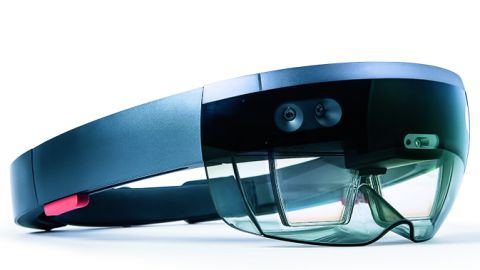
Hands on Microsoft HoloLens review: has Microsoft’s augmented-reality headset been worth the wait?
So, I’m in a room swarming with rats, with a rather unsavoury character who’s pointing a gun at a child’s head. Lovely.
Now I’m in a Volvo showroom. But it’s really exciting!
And now I’m constructing and spray-painting floating widgets, while a Blade Runner-esque, replicant ballerina pirouettes in the background. Although, to be honest, that could just be my flat on any given day.
Welcome to the Microsoft HoloLens. This pair of augmented-reality (AR) ‘goggles’ is actually somewhere between a cycling helmet and a futuristic welding mask. You’re probably already familiar with virtual reality (VR) from the likes of the Oculus Rift, the HTC Vive and the Samsung Gear VR; and with the concept of AR from Pokémon Go.
Where VR replaces your reality with another one, AR layers graphics (‘holograms’, Microsoft calls them) over your actual surroundings, so you can see monsters in your garden without needing recourse to LSD.
Unlike the Rift or the Vive, the HoloLens is totally wireless. That’s because, as well as the screens that paint the holograms over your surroundings, this bulbous RoboCop helmet also houses all the necessary processing power and cameras to enable it to ‘see’.
For this reason, and the fact that you can still view the room you’re in, you can walk around freely while wearing the HoloLens. Speakers add surround sound for a more immersive experience.
Sophisticated software maps your surroundings, then plonks the holograms into available spaces and onto surfaces – not just walls and floors, but also furnishings in your gracious home – tables, for instance.
So, in the app with the unpleasant, gun-wielding chap, you must look for clues as to what’s going on. But they’re not just pinned to the wall, they’re also sat on whatever furniture happens to be in your room, or even under it.
Similarly, in the virtual Volvo showroom – the real-life version of which I travelled to Microsoft’s base near Seattle to see – cars sat in miniature on table tops so that I could scroll through the colour and trim options, and could then be viewed and walked around, in full size, on a stage. I couldn’t kick the tyres, though.
Now, this is all very exciting, but the HoloLens is only available to developers at the moment, and in some respects it doesn’t feel like a finished product.
The most important thing to understand about this helmet is hard to convey, but bear with me. What you see is NOT simply the world with holograms added to it. No, what you see is the world, with holograms filling a ‘screen’ hanging a few inches in front of your nose.
The issue with this is that if you get too close to a large hologram, the edges of it will begin to shear off. The best way I can describe it is that it’s like looking at VR but through a letterbox.
In the Volvo showroom, everything easily controlled so that I was always the right distance from the virtual objects to minimise this effect. A set had been constructed and I was guided around it.
However, viewed ‘in the wild’, the HoloLens is a very different experience. Human characters in games have an impressive solidity but no legs – until you look down, at which point their legs come into view, but you can no longer see their heads. It’s a kind of tunnel vision.
Control of menus and virtual objects comes via a mix of voice control and gestures, although there’s also a handheld mouse if that’s 2 Future 4 U.
The most common gesture is the ‘air tap’, where you bring your ring finger down to meet your thumb, like you’re crushing the head of someone in the distance. You can also rotate objects by, yes, rotating your hand, and exit whatever you’re doing with a dismissive opening of your fist, like you’re releasing a butterfly back into the wild.
Now, by no means am I in terrible shape, but I was f**king knackered after doing gestures for a few minutes, for this article. Because of this, and its visual limitations, the HoloLens strikes me as more or less useless as a gaming device – and Microsoft isn’t going out of its way to push it as one.
However, as a tool for more serious matters – education, industrial training, electrical and plumbing repairs, and surgery – and also for things like ‘experiential marketing’, the HoloLens could one day be an invaluable tool. Despite its obvious flaws, I really like it.
[Source:- T3]
The post Hands on Microsoft HoloLens review: has Microsoft’s augmented-reality headset been worth the wait? appeared first on .
This content was originally published here.


